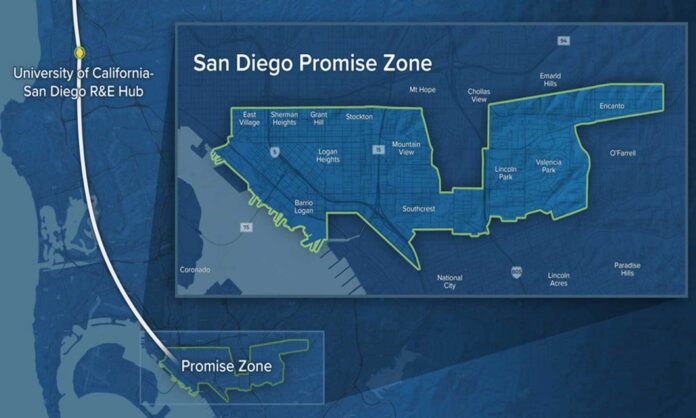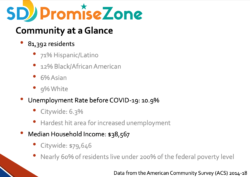
By Macy Meinhardt, Voice & Viewpoint Staff Writer
Since 2016, much of Southeastern San Diego has been among the twenty-two communities in the country that received a “Promise Zone” designation by the federal government. The designation helps strategically target systemic disparities in an area historically burdened by the highest concentrated poverty and unemployment rates.
In last week’s San Diego City Council meeting, members from the San Diego Promise Zone initiative presented an update on the program’s success since its designation in 2016. The informational report highlighted robust funding—accumulating over $2.5 billion dollars—in the last six years in areas such as job creation.
However, in the backdrop of long-lasting aches and frustration at government bodies for the January floods, the report did not go without criticism from the public; ultimately highlighting how much work really will need to be done to win back public trust.
“The goals of the Promise Zone was to create and preserve affordable housing. Yet, the City of San Diego allowed low income and very low income housing to be located there without any market rate development. Naturally, without any market rate development there is no growth in economic development. There are food deserts in that area. There is a lack of interest in building, there are no companies and organizations that are building there and operating there to create jobs. This is not the Promise Zone but rather more of the Forgotten zone,” said resident Maria “Mia” Severson.
The San Diego Promise Zone program is a 6.4 mile area designation that is home to over 80,000 residents, spanning from East Village and Barrio Logan east to Encanto. The area captures the City’s most culturally rich and ethnically diverse neighborhoods. But, it also has historically high unemployment rates, low educational attainment, insufficient access to healthcare, higher crime rates, and the least available affordable housing compared to the City as a whole. To target these areas, the “promise” of the program is:
“To co-create an ecosystem of opportunity and investment through collaboration that addresses systemic racism and inequities to improve the quality of life of promise zone residents.”
One caveat to the program is that it does not come with any federal funding attached to support it, so responsibility of administering the goals falls in the hands of the City of San Diego, particularly the City’s Economic Department. However, as one of only 22 promise zone designations declared in the whole country, the federal recognition opens the door to a lot of grant opportunities. In addition to partnering with community based organizations, the program provides five full time Vista AmeriCorp volunteers to work within these communities. Working groups for the program also help leverage funding opportunities from a variety of sources, including federal, state, local, corporate, and philanthropic. Over the years partners have pursued more than 200 grant opportunities, resulting in over $100 million in funding.

Below is a list of the program’s goals, and the funding that has been dispersed since then.
Main Goals:
- Increase access to quality and affordable housing…..$159.5 million
- Promote access to healthcare and healthy foods…..$52.2 million
- Create a priority of safety….$750 million
- Improve educational opportunities…..$16.3 million
- Increase economic activity and creating jobs…….$1.6 billion invested
Despite the economic investment snapshot shared, disappointment and frustration with the San Diego Promise Zone were expressed by several participants, who argued that it has failed to deliver on its promises of economic development in historically neglected communities.
“The promise zone sits on top of the Encanto and Southeastern community plans, statistics shows the area is as segregated, economically deprived, redlined, as ever….it is a concentrated poverty program, it is a broken promise,” said resident Mike O’ Geary, in regards to the report.
Indeed, a recent redline report conducted by local researcher David Oddo, does highlight the premise of redlining in Southeastern San Diego, and the devastating generational economic impact it has had. For instance, in terms of home ownership, Latino and African Americans in these identified communities are greatly under-served in terms of receiving home purchase and refinance loans.
Furthermore, as poverty also intersects with health outcomes, recent data produced by the County of San Diego, shows Southeastern San Diego consistently ranked disproportionately in areas such as: behavioral health conditions, asthma, diabetes, cancer, heart disease, and stroke
Yet, In terms of unemployment, according to an SDPZ statement, their data shows that “since 2016, the unemployment rate has decreased from 14.9% to 9.9%, and the poverty rate has fallen from 38.3% to 20.3%”
“We recognize there are many factors that contribute to these numbers. We do know that in the 7 years since the designation, targeted efforts from the city and community-based organizations have supported some improvement in these areas, however, we recognize there is still plenty of work to do to continue improving the lives of our Promise Zone residents.”
While other comments during public comment accused the presentation of being a “propaganda update” and using “false data”, councilmembers for the most part accepted the report positively, emphasizing that although the work put in since 2016 has been vital, the road to full equality for the region is still long.
“Although the promise zone has been helpful, the decades of neglect by the city and private development are still extremely evident, ” said District 8 Councilmember Vivian Moreno.
In addition, Councilmember Moreno also challenged the division to seek new potential CIP projects that can be targeted and come into fruition before the designation ends.
For feedback from Council President Sean Elo-Rivera on the item, his suggestion was to focus more on gathering survey data from residents in the designation—are they seeing and feeling the improvements of the investments?
Representatives from the division said that the designation outlines one survey in the beginning of the program, which was completed, and one at the very end which will be in 2026.
“How do you specifically measure the outcomes and the results? And if our homelessness crisis is accelerating, and deaths are accelerating of people who are forced out of housing, then all of this money being spent, over a billion dollars? What do we have to show for it in the end?” said resident Lori Saldana.
Meanwhile, in regards to the program ending in two years, other statements submitted for public comment consisted of a plea from the Urban Collaborative Projects for the city to keep a strategic focus on this area.
“We would like the City Council and the Mayor’s office to understand that just because the Promise Zone is going away, it does not mean our needs are going away. We propose that the city fund a community driven promise zone model once the federal designation is lost to ensure a smooth transition of activity and continued investment.
“Our hope is that we begin this conversation sooner, rather than later. Because of the recent flooding (see attached map), we have been reminded of the importance of infrastructure improvements that affect both the residents and businesses in our community.”
In essence, while the Promise Zone initiative has yielded tangible improvements, its conclusion marks not an end, but a call to action for sustained commitment, collaboration, and investment in fostering lasting equity and prosperity for Southeastern San Diego residents.
To learn more about the San Diego Promise Zone Program visit: San Diego Promise Zone
What is your viewpoint on the progress of the San Diego Promise Zone Program? We want to hear from you! Email us your thoughts at: [email protected]



